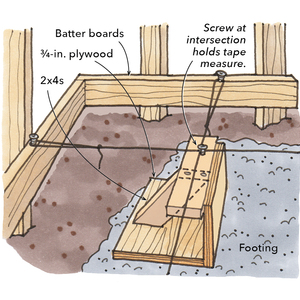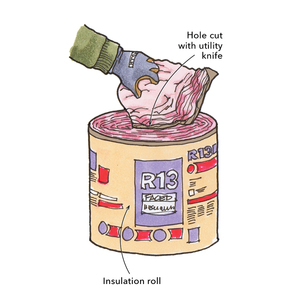Stone veneer – Moisture barrier or trap?
I am using Eldorado stone veneer for my exterior, and I got to talking to the GC about it. The house is sheathed in OSB, and he said he was planning a layer of Tyvek over the OSB, then a layer of felt, then a layer of expanded steel (diamond mesh) to hold a scratch coat, then the stone itself. I got to wondering whether there might be an issue with sandwiching the felt paper, maybe trapping moisture over time?
Also, are there any issues with running the stone veneer all the way down over the stem wall down to the footing (foundation is a slab)? The final grade will probably push soil up over the footing, so likely a coulpe runs of the rock will be in contact with/buried by dirt. Should I have a couple of rows of brick run on top of the footing to make sure stone is above grade?
As always, I certainly appreciate any and all input or advice……
VS



















Replies
I got to wondering whether there might be an issue with sandwiching the felt paper, maybe trapping moisture over time?
As long as the paper is installed so it sheds water there shouldn't be anyway for water to wick up between the two and cause problems.
We do like to Ice and water corners since felt doesn't make 90 degree bends very well.
I know--reading instructions is a major step, but if you are interested in the stone venier warranty, you might run a question by the GC as to how the OSB effects things. If I remember right eldorado's installation instructions specifically say cracking may occur if applied over OSB. Of course we all know that's just an easy way to get out of most warrantee claims since 90% of new construction is all osb.
Most guys who don't know anything about flashing for stucco or stone veneer will screw up at window and door openings. Mortar or stone in direct contact with wood is a no-no. Flashings have to be used and moisture has to have a way to drain out of the wall if it gets in and weeps down to the lower areas.
Personally, I'd want the rock to not be buried in the soil, but stop right at the surface or a little before and the gap will be hidden by grass or plants. Otherwise freeze thaw cycles and constant moisture from the ground can be hard on the thin mortar and stone.
Good luck
Beer was created so carpenters wouldn't rule the world.
Yikes! Didn't realize the issue with OSB sheathing. I just went to the website and found that you were indeed correct. Also noted that they recommend a minimum of 4 inches above dirt level so that there is no moisture wicking up into the stone. Looks like I'll be calling the Eldorado guys tomorrow. I REALLY appreciate the heads-up. Any other thoughts are greatly appreciated......Greg
Most of the eldorado products used in our town are on commercial projects which all use osb. Even the architects are specing osb under the stone. So, you aren't out of your mind to use it over osb, it just isn't going to help your warrantee.
Personally, the method I like the most is using a base which is essentially a stucco finish without the final coat. Then the stones are applied with thinset like big tiles. Our stucco guys know how to do the base well with materials they are used to and any tile or stone guy can place the stones knowing the moisture managment issues are being taken care of.
I know it doesn't seem normal, but it's using the strengths of each sub instead of either having a guy good at stucco and terrible at placing stones, or a stone guy who doesn't have a clue about moisture management on the base.
Unfortunately, many people get into stone venier who aren't good at either and by the time water issues are found they are long gone and you are stuck trying to figure out how to fix a rotten house. Hard to fix after the fact.
At least I'd get a copy of the water management guidelines refferenced by eldorado in their installation instructions and require your contractor to follow them as a minimum.
Best of luck.
Beer was created so carpenters wouldn't rule the world.
Thanks for the sage advice. I've not had a chance to engage with the GC, but I plan on talking to him about how he plans to finish off the door/window interfaces, and have him wrap the corners with Ice and Water before they lay down the felt. I know he's had experience with stucco installs, so I plan on talking to him about maybe going the "almost stucco, but use thinset" approach you suggested.
I did get to wondering about Bonzini's suggestion in the follwong post regarding using durock over the sheeting, and applying the veneer to that. Durock is more expensive, but it does save the labor cost of installing the diamond mesh ($.50/sq ft) and and setting the scratch coat(s). Any thoughts or experiences with that technique? BTW, I've got about 3000 sq ft to cover, 80% is first story.
Beerz.
Durock is more expensive, but it does save the labor cost of installing the diamond mesh ($.50/sq ft) and and setting the scratch coat(s). Any thoughts or experiences with that technique?
I honestly don't know how well durrock is on an exterior application. I do know that a good stucco job will outlast us all.
Be sure and let us know how it all turns out.
Beer was created so carpenters wouldn't rule the world.
Thanks, I'm thinkin' the Duroc may be too sporty of a chance to take - I'm going the stucco route. I'm probably a couple months from getting the rock up, but I'll keep you posted.Here's a last (?) question, if you have any thoughts one way or the other: do I use Tyvek over the OSB and under the felt? The Eldorado distributer said that he's not heard of that - usually the felt is attached directly to the OSB, then diamond mesh/stucco. My thinking is that the Tyvek acts as a one-way moisture barrier, whereas the felt isn't and so it's better to have the Tyvek. I thought I had read in other posts, though, that it's not a good idea to sandwich felt between Tyvek and stucco bedding. I could see some rationale either way...
You might consider DensGlass Gold sheathing if you are concerned with the OSB. It is an approved substrate for most drainage-type EIFS and will work for stucco also.
The two layers of drainage material is critical. Tyvek & felts will wick moisture thru them when mortar is in direct contact with them. This will happen when the mortar base extrudes thru the lath. The old paper rag felts would wrinkle and debond from the mortar when installing stucco when everything cured. The newer fiberglass felts don't wrinkle- they just stay stuck.The wrinkled felts would give you a drainage plane for moisture that gets thru the stucco. (Consider cultured stone to be stucco with a fancy finish coat. The stones are a cementitious material, just like stucco and use the same mortar, lath and flashing. It has the same fundamental issues with detailing around openings as stucco). The moisture barrier material closest to the mortar base will stay bonded to the base mortar and will not function as a moisture barrier- that's the job of the second layer. Ice & Water Shield or Ultra is a good idea at corners. None of the material manufacturers tell you about any of this stuff, although most have good detail information on their websites. Check out Owens-Corning. They are a competitor to Eldorado Stone & I've used their details recently.
You will nee a weep screed at the bottom of your wall, just like stucco, Keep at least 4" clear between the bottom of the screed & ang grade except paving. You can go to 2" if you have asphalt or concrete paving.
Good luck & keep asking questions.
Tyvek is pourous enough to let vapor through but liquid water is typically too large to wick through. Same for building felt. They are interchangible for most purposes for use as a building wrap, but the building felt sheds water better than typical Tyvek so I don't see the advantage of using the Tyvek at all, especially since it isn't rated for use under stucco and leaks water more than building felt.
A suitable alternative to building felt are the house wraps made for use under stucco. Building felt goes to pot after 100 years so I can see the benefit of a product that holds up better for the houses later years. Are we building for 100 year life spans or for indefinite lifespans? If it's the latter maybe building felt isn't the best alternative.
Good building
Beer was created so carpenters wouldn't rule the world.
Hmmmm. What I was thinking is that the Tyvek will let the water vapor vent from the house-side and prevent water incursion from the exterior side. But if I used just felt, then that would trap the water vapor between the OSB and felt, and maybe allow water vapor migration into the OSB through the seam overlaps in the felt runs, whereas Tyvek is a continuous sheet with no seams. I like the idea of specialty wraps for stucco, though. Do you have any brands that I could Google for info?
And yes, I'd like to build this home for the long haul - it is the way it should be. The Egyptians had a point....
If you don't mind me throwing in my 2 cents, the commercial buildings we work on are more frequently calling out Tyvek then tar paper over the sheating (yes, plywood, not OSB). Maybe the architects are on to something, in that the building paper has some redundancy and perhaps tar paper does better against mortar than Tyvek? I don't know but in that there is no drainage plane like a brick veneer, it seems like a good idea.
Here in NW FL they are using hardibacker for the lath.
FWIW I don't use/allow Tyvek or OSB on any work, only felt and plywood.
The latest Tyvek product does come in a 'wrinkled' texture though, to create a drainage plane - if you use it just make sure the striations run vertically ;ol
Jeff
What I was thinking is that the Tyvek will let the water vapor vent from the house-side and prevent water incursion from the exterior side.
That's also what building felt does.
Beer was created so carpenters wouldn't rule the world.
my neighbor put cultured stone on durock that he screwed to his walls, then capped the step out and flashed it where the siding begins. looks pretty good. see the latest fine homebuilding. certain cement boards are not for exterior. thanks FHB. never knew that myself."it aint the work I mind,
It's the feeling of falling further behind."Bozini Latinihttp://www.ingrainedwoodworking.com
3 yrs ago I did almost the same thing - only difference -- had copper flashing that the stone set on the concrete ledge, I had weep holes every 2 feet, gravel against the concrete and up to a portion of the stone so the weep holes would not get filled, 4" drain tile at the bottom of the gravel, and lastly wall ties along with the diamond mesh nailed staggered every other 2x4 and every foot of the wall.
The stoe has not move and everything is great at this point